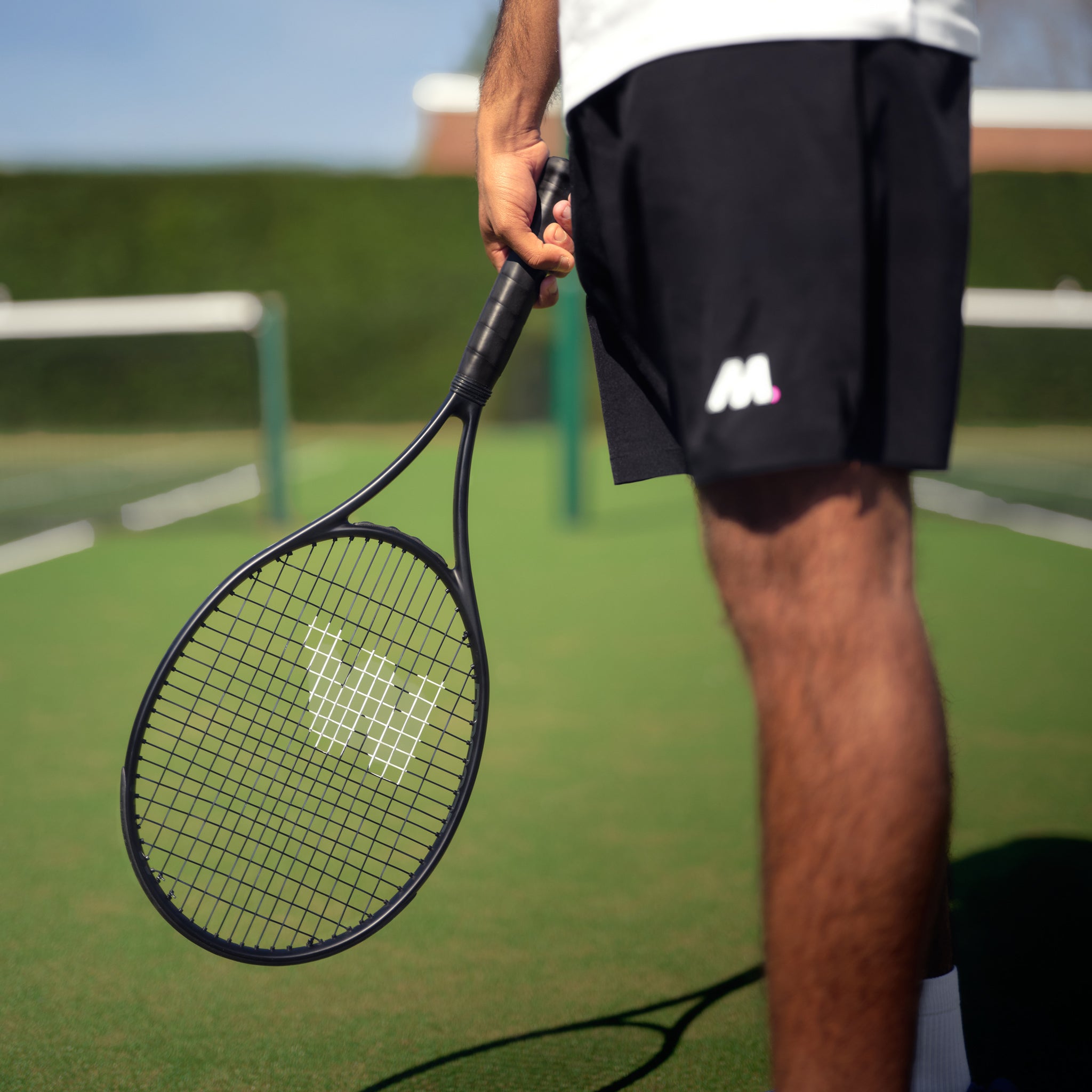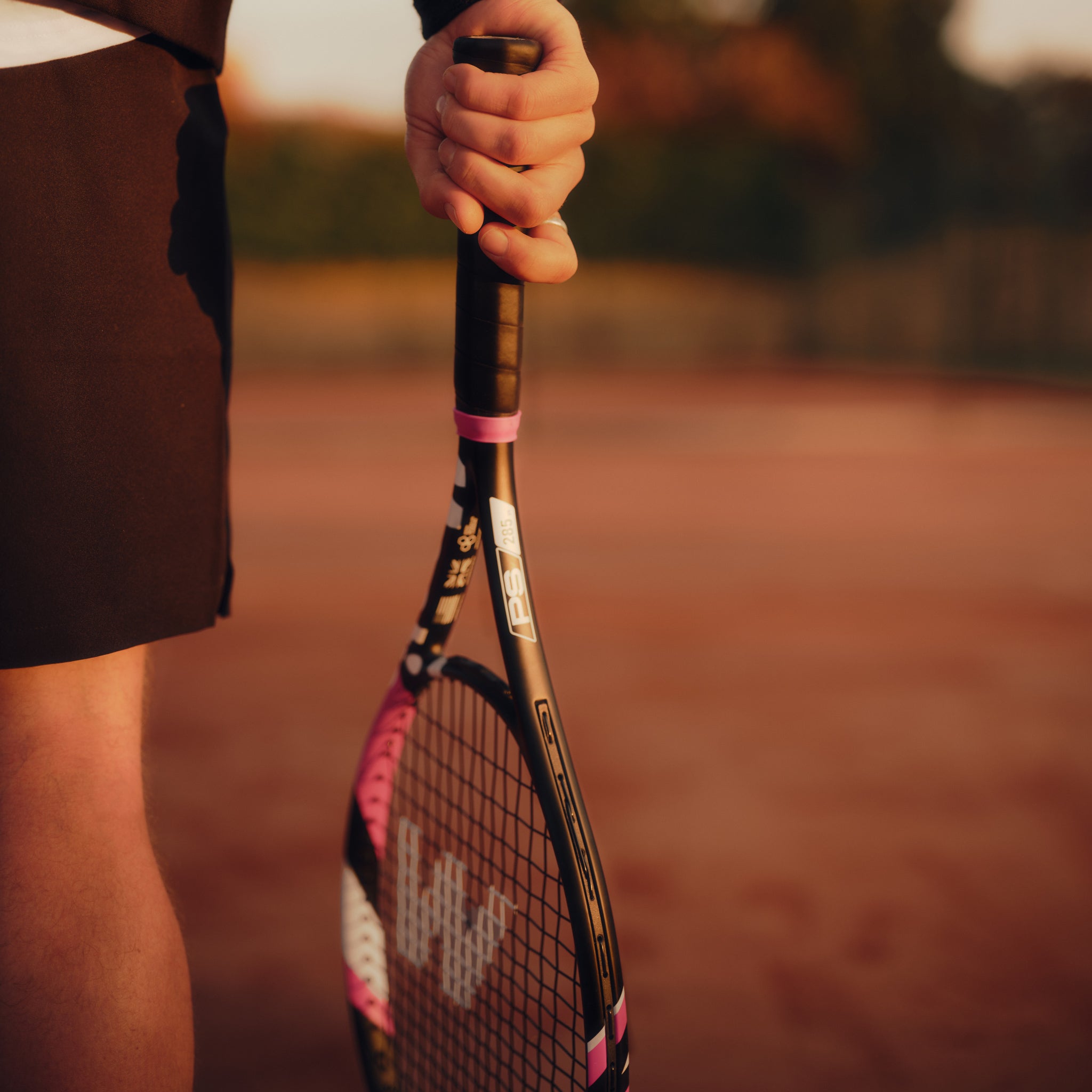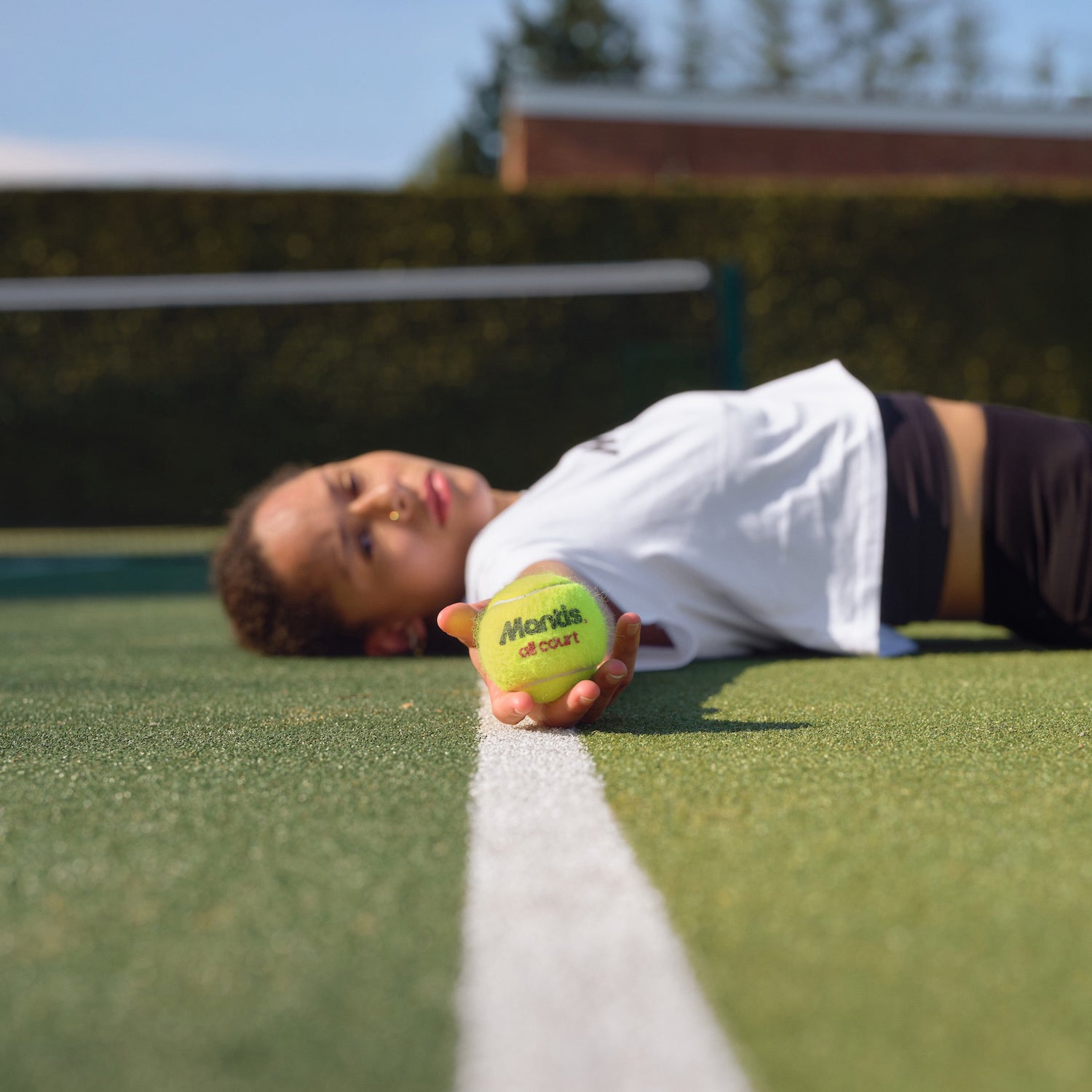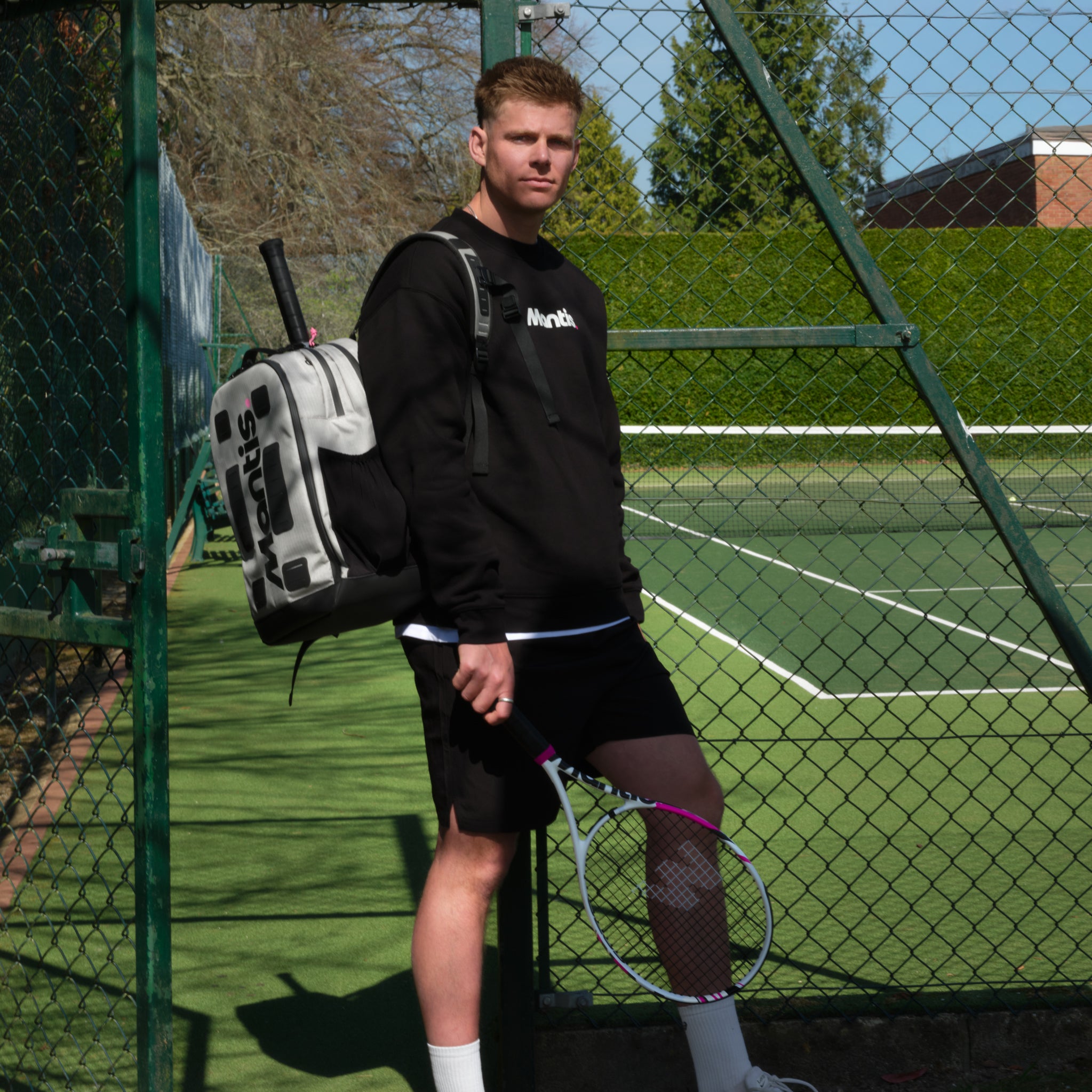
Before you can sidestep tennis elbow, you first need to get to grips with what it actually is. It's a classic repetitive strain injury that targets the tendons on the outside of your elbow, usually flaring up from overuse in activities that demand a strong grip or constant wrist movement. To really learn how to prevent tennis elbow, you can learn how to choose a tennis racket that will help protect your elbow from unnecessary strain.
To really learn how to prevent tennis elbow, we believe in a simple, player-focused approach: understand the root causes, spot the symptoms early, and arm yourself with the right gear—like our range of equipment designed for committed players.
What Is Tennis Elbow and Who Is at Risk?
Tennis elbow, or lateral epicondylitis if you want the clinical term, is an issue that reaches far beyond the court. Despite its name, only a small fraction of cases are actually linked to racquet sports. The injury comes from repetitive strain on the forearm's extensor muscles and the tendons connecting them to that bony bit on the outside of your elbow. The best place to start is with the right equipment, and you can learn how to recover muscles faster with the correct gear.
When these tendons are pushed too hard, tiny tears can develop, which leads to the inflammation and pain that define the condition. This isn't just about hitting a blistering backhand; it can happen from any activity involving repeated gripping or wrist extension.
Who Is Most Affected?
While tennis players are certainly in the firing line, so are countless professionals whose jobs involve repetitive hand and arm motions. Think of painters, plumbers, chefs, and even office workers clicking a mouse for hours on end. That constant, low-level strain can be just as damaging as the high-impact forces you see in sport.
In the UK, it’s a surprisingly common problem. Data shows that around 1 in 200 people see their GP about tennis elbow symptoms each year, making it a widespread musculoskeletal issue. While it can strike at any age, it’s most common in people between 40 and 60. You can read more about these findings on the NHS Lanarkshire website.
It’s a common myth that tennis elbow comes from a single, big injury. The truth is, it’s usually the result of slow and steady wear and tear over weeks or months, which is exactly why getting ahead of it is so important.
Recognising the Early Warning Signs
Catching the problem early is the single best thing you can do to stop it from becoming a long-term headache. At Mantis, we encourage everyone—players and non-players alike—to listen to their bodies and recognise those initial whispers of trouble.
Keep an eye out for these common indicators:
- A dull, nagging ache or a burning feeling on the outside of your elbow.
- A noticeable drop in grip strength—whether you’re holding a racquet, a coffee cup, or shaking someone’s hand.
- Pain that gets worse with simple forearm movements, like turning a doorknob or using tools.
By understanding what tennis elbow is and who’s most vulnerable, you’re already in a much better position to take proactive steps and keep yourself in the game.
Your Essential Pre-Game Warm-Up and Post-Game Cool-Down
Jumping onto the court with cold muscles is one of the fastest routes to injury, and that’s especially true for tennis elbow. Think of a proper warm-up not just as a suggestion, but as a non-negotiable part of getting your body ready for the game. For a deep dive, check out our dedicated article on tennis warm-up exercises.
At Mantis, we see these routines as essential for priming your forearm muscles and tendons for action. A good warm-up increases blood flow, preparing the connective tissues for the high-impact forces of every single shot. This simple preparation drastically reduces the risk of the microscopic tears that eventually lead to pain.
Pre-Game Dynamic Warm-Ups
Before a match, your focus should be on dynamic stretches—these are active movements that get your muscles firing and joints lubricated by mimicking the motions you'll use in a rally.
- Arm Circles: Start small and get progressively larger. Make sure to go both forwards and backwards to wake up the entire shoulder girdle.
- Light Resistance Band Work: Grab a light band for some wrist extension and flexion exercises. This gently activates the exact muscles that are so prone to tennis elbow without over-stressing them.
- Torso Twists: A few gentle twists from side to side will engage your core. A strong core helps generate power, so your arm doesn't have to do all the heavy lifting.
Post-Game Cool-Down and Recovery
What you do after the match is every bit as important as what you do before. A cool-down helps your muscles recover and maintains your flexibility, which is vital for long-term joint health. Now is the time for static stretches, where you hold a position for a longer period.
A common mistake is packing up your bag and heading straight home. That cool-down period is when your body flushes out metabolic waste from the muscles and gradually brings your heart rate down, kickstarting the whole recovery process.
Learning how to recover muscles faster is just as crucial as your warm-up for keeping your elbows healthy and avoiding chronic strain.
One of the most important stretches is the wrist extensor stretch. Extend your arm straight out, palm facing down. Use your other hand to gently bend your wrist downwards, feeling the stretch along the top of your forearm. Holding this stretch directly targets the tendons that get overworked.
This simple habit helps combat the surprisingly high incidence of tennis elbow. Epidemiological studies in the UK place it at 2.45 per 1000 person-years, a rate that climbs for players over 40.
Build Resilient Forearms with Targeted Exercises
True prevention for tennis elbow goes way beyond just warming up on the court; it starts with building real strength in the muscles that support your elbow joint. A solid strengthening programme is a core part of player longevity, making your forearms far more resilient to the shock and strain of every single shot. Think of a strong forearm as a natural shock absorber, protecting those delicate tendons around the elbow. To understand more about treatment options you could read about 10 essential chronic pain treatment options.
A well-structured routine needs to target both the extensor muscles on top of your forearm and the flexor muscles underneath. These muscle groups work together to stabilise your wrist during impact. When they're weak, the tendons end up taking the brunt of the force, which leads to the micro-tears that cause tennis elbow.
Mastering Foundational Strengthening
The goal here is to introduce stress to the muscles gradually, encouraging them to adapt and grow stronger without causing injury. Honestly, consistency is far more important than intensity, especially when you're just starting out.
Two of the most effective exercises you can do are reverse wrist curls and simple grip strengthening. These movements directly hit the extensor carpi radialis brevis (ECRB), which is the muscle most commonly affected by tennis elbow.
- Reverse Wrist Curls: Grab a light dumbbell (or even a can of soup from the cupboard), and rest your forearm on your thigh with your palm facing down. Slowly lower and raise your hand, making sure to keep your arm completely stable.
- Grip Strengthening: Using a stress ball or a grip trainer, just squeeze and hold for a few seconds before slowly releasing. This is a brilliant exercise you can do almost anywhere—at your desk, while watching TV, you name it.
The key to preventing tennis elbow isn't just about building raw power, but about developing endurance in the forearm muscles. This endurance is what allows them to handle the repetitive demands of a long match or practice session without fatiguing and transferring stress to the tendons.
This image shows the correct form for performing a wrist curl, a cornerstone of any good forearm strengthening routine.

Visualising the proper technique helps ensure you’re isolating the forearm muscles effectively. Getting this right is crucial for maximising your results and, just as importantly, minimising any risk of injury.
Creating Your Progressive Plan
A smart strengthening plan should be adaptable. You always want to start with light weights and low repetitions, focusing entirely on perfect form. As the exercises become easier, you can progressively increase the weight or the number of reps.
To give you a clear path forward, here’s a simple, progressive table you can follow.
Forearm Strengthening Exercise Program
| Exercise | Beginner (Sets x Reps) | Intermediate (Sets x Reps) | Advanced (Sets x Reps) |
|---|---|---|---|
| Wrist Curls (Flexors) | 2 x 15 | 3 x 12 | 3 x 15 (with more weight) |
| Reverse Wrist Curls (Extensors) | 2 x 15 | 3 x 12 | 3 x 15 (with more weight) |
| Grip Squeezes (Stress Ball) | 2 x 20 | 3 x 15 (with grip trainer) | 3 x 20 (higher resistance) |
| Hammer Rotations | 2 x 10 (each way) | 3 x 10 (each way) | 3 x 12 (with more weight) |
Start at the beginner level and only move on when you can complete all sets and reps with good form and no pain. A good starting point is two to three sets of 10-15 reps, performed two to three times per week on non-consecutive days to allow for recovery.
To further support the strength and resilience of your forearms and get professional guidance, you might also consider exploring physiotherapy treatments.
Learn How to Prevent Tennis Elbow by Refining Your On-Court Technique
Even the strongest, most well-conditioned arm is vulnerable if your on-court technique is flawed. Subtle adjustments to your mechanics can make a huge difference in preventing tennis elbow by reducing the repetitive strain that causes it in the first place. At Mantis, we often see players making the same small mistakes that, over time, lead to big problems. There is so much information about how to prevent tennis elbow online like these articles about physiotherapy treatments.
A common one, especially with beginners, is trying to generate power using just the arm. This is a classic recipe for overloading the forearm muscles and tendons. Real power should come from a kinetic chain—a sequence of movements starting with your legs, moving through your core, and finishing with your arm. It's about flow, not force.
The Backhand Problem
The one-handed backhand is a notorious culprit behind tennis elbow. It places enormous stress on the extensor muscles to stabilise the wrist through impact. If your core rotation is weak or your timing is just a fraction off, your elbow ends up taking all the punishment.
Switching to a two-handed backhand is a simple yet incredibly effective fix. This one change distributes the load across both arms and encourages you to use your core for rotation and power. It immediately takes pressure off the elbow joint.
Key Technical Adjustments for All Strokes
Whether you're hitting a forehand, backhand, or serve, a few universal principles apply. By building these into your muscle memory, you can forge a more sustainable and elbow-friendly game.
- Hit the ball out in front. Making contact late, when the ball is beside your body, forces your wrist to do all the work to "flick" the ball over the net. Focus on meeting the ball well in front of you. This allows for a much smoother transfer of energy and a more natural swing path.
- Generate power from the ground up. Think of your true power source as your legs and hips. By bending your knees and rotating your core, you create effortless force that flows through the racquet, rather than trying to muscle it with your arm.
- Stay relaxed. A tight, tense "death grip" is a fast track to forearm fatigue and injury. Keep your hand and arm relaxed throughout the swing, only firming up at the moment of impact. This small change dramatically reduces muscle strain over a match.
Why Your Racquet and Strings Are Critical for Prevention
Your equipment can either be your best friend or your worst enemy in the fight against tennis elbow. It's something we see all the time at Mantis: a player develops a nagging ache, and the culprit is often hiding in plain sight in their tennis bag. We have other articles about tennis warm-up exercises that may help.
The right gear works by absorbing shock before it ever reaches the tendons in your arm. A racquet's weight, balance, stiffness, and even its strings all dictate how those jarring impact vibrations travel from the ball to your body.
For a deeper dive, you can learn all about how to choose a tennis racket in our comprehensive guide.
Finding the Right Racquet Balance
There’s a common myth that a lighter racquet is always the best choice for avoiding injury, but that’s not necessarily true. An extremely light frame can actually vibrate more on off-centre hits, sending all that harsh feedback straight into your elbow.
A slightly heavier, more head-light racquet is often a smarter choice. The extra mass in the frame helps it absorb more of the ball’s impact, so your arm doesn't have to. Meanwhile, the head-light balance keeps it feeling manoeuvrable, meaning you don’t need as much muscle to get it moving.
On the other hand, a very stiff racquet frame might give you more power, but it comes at a cost. It offers less forgiveness and sends more shockwaves up your arm with every shot. A more flexible frame acts as a natural buffer for your elbow by absorbing more of that initial impact.
The Importance of Strings and Tension
Never underestimate the role your strings play in shock absorption. Stiff polyester strings are popular for their durability and control, but they are notoriously harsh on the arm. For players worried about tennis elbow, softer strings are a much more forgiving option.
Opting for softer strings like multifilament or natural gut at a lower tension can dramatically reduce the shock transferred to your forearm. This simple equipment change is one of the most effective ways to make your setup more arm-friendly.
Choosing a larger grip size can also make a real difference, as it helps prevent the over-squeezing that leads to muscle fatigue and, eventually, strain.
Of course, while equipment is a key part of prevention, if the pain continues, it’s vital to get professional guidance. In the UK, NICE clinical guidance recommends physiotherapy as the preferred conservative treatment. The goal is to gradually load the tendon to encourage recovery and build resilience. You can discover more about these physiotherapy-led approaches and their effectiveness in managing tennis elbow.
Common Questions About Tennis Elbow Prevention
When you're trying to stay ahead of an injury, you're bound to have questions. It's one thing to read a list of tips, but it's another to know how they apply in the real world. At Mantis, we get these questions all the time, and we believe clear answers are the key to keeping you healthy and on the court. There is so much advice and tips on the NHS Lanarkshire website.
Let's tackle some of the most common ones we hear from players.
One of the big ones is, "When is a slight twinge a serious warning sign?" It’s a great question. A minor ache that vanishes once you’re properly warmed up probably isn't a red flag. But if that pain sticks around after you play, or you feel it doing simple things like lifting a coffee cup, that's your body telling you to stop. It's a clear signal to rest up and take a hard look at your technique and gear.
How Long Should Strengthening Take?
Another question that comes up a lot is about the timeline for building up that resilience in your forearm. The key here isn't intensity; it's consistency. If you're doing the right exercises two or three times a week, you should start feeling a real difference in your forearm endurance within about four to six weeks. We're not aiming for huge muscles here, just the stamina to handle the repetitive nature of tennis.
The single most important prevention tool you have is your own body's feedback. Pushing through sharp or nagging pain is a recipe for disaster, turning a small problem into a chronic one.
Are Elbow Straps and Braces Effective?
Yes, for some people, they can be. A good elbow strap or brace changes how the forces travel through your forearm tendons. By applying pressure on the muscle just below the elbow, it can take some of the load off that sore spot where the tendon attaches.
Think of them as a supportive tool, not a cure-all. They work best when they're part of a bigger plan that includes strengthening exercises and technique fixes.
While prevention is always the goal, sometimes discomfort becomes more persistent. If you find yourself in that boat, it’s worth understanding all the avenues available. You can learn more about 10 essential chronic pain treatment options to see what steps can be taken if an issue lingers.
At Mantis, we believe the right equipment is a cornerstone of injury prevention. Explore our range of expertly crafted rackets and gear designed to support your game and protect your arm. Visit us at https://mantissport.com to find your perfect match.








